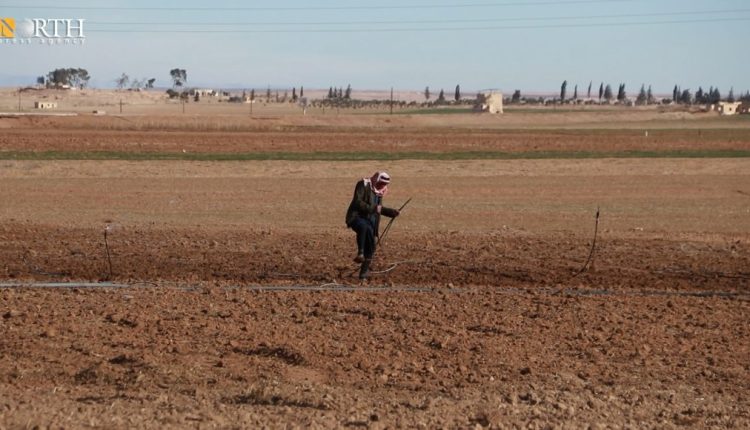
By Dilsoz Youssef
HASAKAH, Syria (North Press) – For the fourth consecutive year, farmers in northeastern Syria face severe drought and dwindling rainfall, threatening their crops and livelihoods. With rising costs, lack of fuel support, and failing rainfed agriculture, many are forced to downsize or abandon farming altogether.
Experts warn that without urgent intervention, the region could face a devastating food crisis.
The elderly farmer Hajij al-Yassin finds himself facing tough challenges in irrigating his field due to low rainfall and drought, threatening significant financial losses that may force him to abandon his livelihood next year.
Climate change
Farmers in northeastern Syria are struggling with a lack of rainfall this season, as climate change increasingly threatens the future of agriculture—the backbone of the economy. This has especially affected northeastern Syria, which is considered the country’s “food basket.”
Standing in his field of wheat, barley, and cumin, al-Yassin told North Press, “My field is 25 dunams, and I scattered 50 kilograms of wheat and barley seeds per dunam, but there has been no rain so far, and the season is a failure. There is also no support to operate diesel engines.”
After adjusting the sprinkler locations to irrigate his cumin crop, he added, “I borrowed money to buy the seeds, and I must repay it by the end of the season. But as you can see, the land is dry, and there are no signs of success.”
The seventy-year-old farmer pointed out that if it does not rain, his losses will exceed 15 million Syrian pounds between wheat and barley (around $1,300 USD).
Due to losses in past years, most farmers in the region have relied solely on rainfed agriculture this year. However, the lack of rainfall has worsened their struggles, adding this season’s losses to those of previous years.
In his field in Umm al-Masamir village, west of Hasakah, farmer Khodr al-Abdullah works hard to irrigate his crops after losing hope in rainfed agriculture.
The farmer, who owns 100 dunams, told North Press, “This is the third time I have irrigated my crops. Some farmers have not irrigated at all yet, and this negatively affects us. If it does not rain, production will be very low.”
Speaking in a tone of despair, he added, “Most of our farming is done with borrowed seeds and plowing costs. I have spent 40 million pounds so far, and the agricultural season is still long.”
He concluded, “If this situation continues, we may have to stop farming in the coming years.”
Lack of support
Although many farmers have installed solar panels due to the lack of fuel support, they have still reduced irrigated farmland because of the rising costs of agriculture.
In Husayniyah village, north of Hasakah, farmer Ali Obeid reduced his cultivated area to 25 dunams out of the 100 he owns, planting wheat, barley, and cumin.
Standing in the sunlight, Obeid told North Press, “I irrigate my crops using wells powered by solar panels. Without irrigation, crops won’t grow due to the lack of rain.”
He added, “Our region has relied on rainfed farming, but due to low rainfall, we have stopped that too. Given the worsening living conditions, we are forced to resort to irrigated farming but on a smaller scale.”
The fifty-year-old farmer noted that his small cultivated area has already cost him 4 million pounds. “All our farming is done on credit, and if the season fails, we do not know what we will do,” he said.
Agricultural experts believe that the rainfed farming season is almost entirely lost due to the crops failing to grow at the right time, threatening a production decline of more than 50 percent.
Agricultural wells
Agricultural expert Burgess Sido told North Press that the delay in rainfall has impacted agriculture by 100 percent, “since rainfall was scarce and then stopped, making this season’s rainfed farming 50 percent damaged.”
Regarding irrigated farming, he added, “Due to the lack of fuel and rising costs of repairs and oils, most agricultural wells have shut down. Farmers using solar power—who make up no more than 20 percent—have also reduced their cultivated areas.”
Sido described this agricultural season as “below zero,” stressing that authorities must support agriculture.
He explained that in previous years, rainfall before New Year’s would revive crops. Even if rain was delayed until February or March, the crops would still grow. But this year, no rain has fallen, and even if it does now, production will be poor.
Amid the ongoing military conflict in the country, despite the fall of the previous regime, support for the agricultural sector remains uncertain, leaving the fate of one of the country’s most vital sectors in question.
Many fear that if farmers continue to suffer losses year after year due to climate change and lack of support, the region could face a humanitarian crisis in securing food in the coming years.
